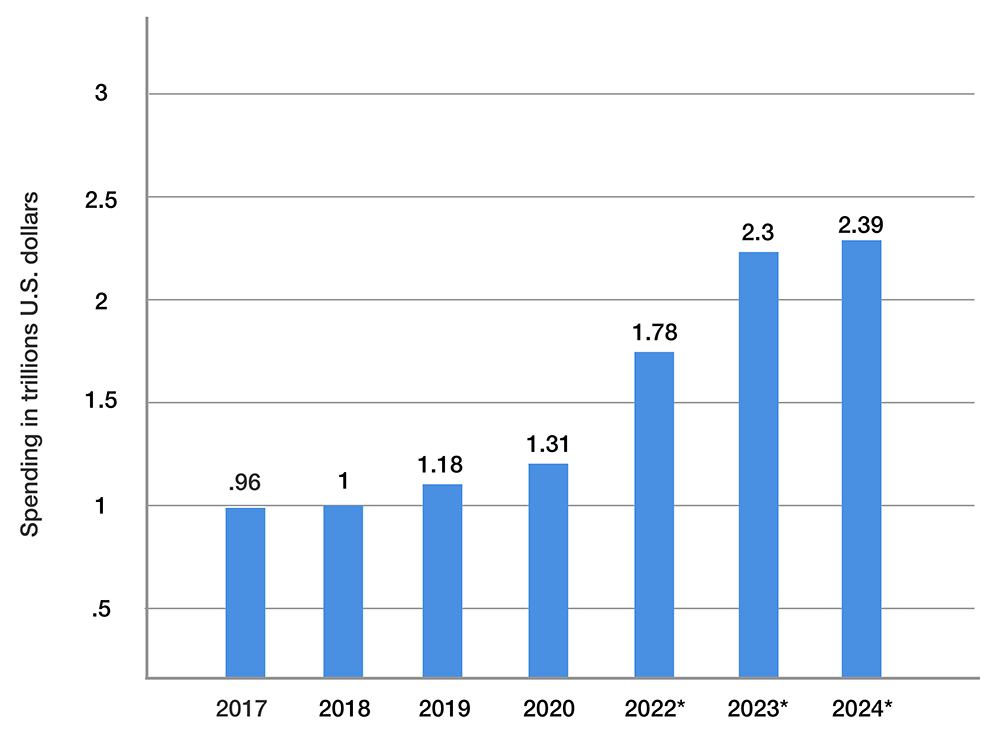Roadmaps are crucial to the success of digital transformation projects. But they’re misunderstood, and often misapplied. In many cases, companies don’t have a roadmap at all! Where they do, it’s often not doing what it should for them.
The average digital transformation roadmap is too long and unwieldy to guide companies through a process that can involve multiple recalibrations to stay on track amid changing markets, technologies and regulatory environments.
In this post, we’ll look at the importance of a digital transformation roadmap, consider the most common shortcomings, and explain why we think a two to three year digital transformation roadmap works best for most businesses.
Why digital transformation matters
Digital transformation is the process of moving an organization's assets and processes from analog to digital substrates. But merely digitizing the processes you already have isn’t digital transformation. It’s not even really possible.
When you move from the electric typewriter, the fax machine and the phone to G Suite or Office 365, Slack and email, and VoIP, you don’t seek a direct digital equivalent to the old tools, because there isn’t one. As Thomas H. Davenport and George Westerman write in HBR, ‘digital is not just a thing that you can buy and plug into the organization. It is multi-faceted and diffuse, and doesn’t just involve technology.’
G Suite doesn’t just offer you a lot more tools than a Selectric. VoIP doesn’t just save money compared to traditional phone lines. They force on you a different way of working in teams and departments. They change the way you engage with your clients, with your partners, and with the work you do.
Increasingly, the market forces this on you too. Digital transformation is no longer an option. It’s necessary. Businesses operating without effective digital systems are at a major systemic disadvantage in the modern marketplace. Everything takes too long, you can’t reach your customers effectively, and making the right decisions fast enough is incredibly difficult.
This is in large part because customers now form their expectations from consumer tech: smartphones, web apps and mobile apps all offer user experiences that users find positively enjoyable. They bring those expectations to work and expect business services and even the tools they use at work to be similarly easy and pleasant to use.
But it’s also because, behind the scenes and far from the interfaces of consumer web apps, businesses are learning a different set of lessons about digital transformation. They’re seeing how access to huge tranches of data, passively collected from users and then analyzed with advanced machine learning tools, deliver insights that can guide them to rapid, correct business decisions. They’re using those insights to fuel growth. Without them, it’s difficult to compete.
Digital transformations now account for 1.3 trillion dollars in business spend, and rising:

In 2020, eight in ten businesses fast-tracked their digital transformations. It’s a priority, for very good reasons, and yet the majority of digital transformations don’t succeed.
Digital transformations often fail. Why?
Several high-profile digital transformation projects in recent years either failed outright, or petered out with little to show. Procter and Gamble’s 2012 ambition to become ‘the world’s most digital company’ ran aground on the company’s growth rate troubles during the 2008 recession, leading to reorganization of the C suite and reorientation of the company’s digital efforts. In 2015, General Electric’s digital division came to be seen as a money sink for the rest of the organization, focused on size rather than quality.
These are headline cases, but they’re representative. Over 70% of digital transformation projects fail. Why?
One reason is that digital transformations are complex. Another is that they’re not just about taking the same processes that a business is already using and moving them to a digital substrate. The business itself must be transformed in the process. When it emerges from the process, it’s no longer the same company. Businesses that think they can digitize without transforming, or that fail to adequately plan for the transformation, suffer.
This speaks to strategic planning: where does the company want to go? What are its long-term, overarching goals? Even now, too many businesses make the error of thinking they can simply digitize, without changing the way they do business.
Another reason for digital transformation failure is that companies often don’t have a system to reconcile their strategic plans for transformation with what’s happening on the ground. They don’t have a roadmap. If they do, it’s actually too strategic, focused on long-term goals and looking too far into the future. It’s like using a map of the interstate highways to get to the next town. The information is useful, valuable — but not directly relevant.
Digital transformation is not about technology
Let’s confront the first problem first. Digital transformations are about transformation, not digitization. They are fundamentally not about technology. This is one of the main places where digital transformations fail. Of the $1.3 billion spent on digital transformations in 2020, an estimated $900 million was wasted.
Digital technologies won’t leave companies’ operations untouched. Switch to digital and you’ll have to do things differently. You’ll also be able to do different things. But there’s often a mismatch at the selection stage — between digital technologies and their capabilities on one hand, and the company’s mid-term and long-term goals on the other.
In fact, what often happens is that these decisions are made at the tactical level, by department heads or by people in the organization who have the technical expertise required to differentiate between the tools and technologies on offer. That seems like a rational choice — why would you have tech adoption decisions made by someone who doesn’t know CRM from CD-ROM? But, to revisit our maps-and-cars metaphor, it’s like choosing the road before you choose the destination.
Businesses should start from strategy, then select the tools that support that strategy, and then create the roadmap to implement their transformation.
Why roadmaps matter — and what’s wrong with most
The missing piece for many businesses that have made intentional, strategic decisions about their digital transformations is a roadmap.
Once goals and tools have been selected, there needs to be a plan to bring the two together. Between strategy and execution there is hope, where there should be planning.
This is something we see all too frequently. One place it shows up is when a company seems to be doing everything right, but things are getting worse, not better. To pick a real-world example that we’ve seen more than once, suppose you have a business that wants to do high-quality outbound sales. They choose Salesforce and implement it. So far, so solid. But they pour money in, and little comes out. Sales performance metrics are actually getting worse. What’s going on?
The problem isn’t Salesforce. And the sales team is probably good too. It’s the relationship between the two that’s faulty. When we see this, we normally find that it’s a training problem. Salesforce was implemented, sure. But the sales team wasn’t trained on how to use it correctly. So they’re climbing over Salesforce to do whatever it was that they used to do, wasting time and money in the process. Or the call center team doesn’t know what’s happening at all, and they’re still doing their own thing.
You’ve bought a car, and your team is hitching it to the horse. They’re not on board with the transformation process, because an overly technical focus neglected buy-in and training across the organization.
There are other reasons, of course. Some really are purely technical, but it’s very rare. More often it’s a disconnect at the level of organizational or departmental preparation.
On the systemic level, the typical digital transformation roadmap is three to five years’ duration. Remember the state of tech five years ago? Even outside fast-moving technological spaces like marketing, where the number of tools has quadrupled in five years, there are often major technological changes. Regulatory and legislative changes, or shifts in markets and infrastructure, can impact plans too. The plain fact is that a five-year plan is just too long and unweildy to answer the needs of a business that’s trying to become more agile and flexible.
So what should you use?
The 2-3 year digital transformation roadmap
Digital roadmaps need to have both stability and flexibility. Things change, inside and outside the organization. Five years is too long to look ahead. So why is it so often regarded as the norm?
Writing in Econsultancy, Ben Davis argues that it’s probably ‘because it gives enough of a nod to long-term thinking and investment without sounding like a project whose lifespan is far longer than the typical CMO’s tenure.’ Some transformations do take five years, others longer. But the roadmap shouldn’t be determined by an unknown, hard-to-quantify target like ‘transformation complete’ — that might never happen, as Ashley Frieldein points out. Nor should they be determined by the psychology of the teams or individuals involved, though these are obviously important to consider. (It’s best, too, if the main consideration isn’t to ensure reliable income for the consultancy partner.)
We think the optimum length of a digital transformation plan is about two to three years. Prediction is easier. Flexibility is greater. The major changes often take place quite early in the process in any case.
Worse, many roadmaps are a list of wishes. They say what should happen at each stage. But they don’t focus anything like enough, in our experience, on what companies can do to succeed in their digital transformation. That’s where an AndPlus digital transformation roadmap differs. We take each goal, and link it to the actions the company needs to take to achieve it. We aim for a sufficient level of granularity that teams can see what they need to do, but we’re available as the plan progresses to reorient large or small elements, keeping the goal in mind.
The four dimensions of a digital transformation roadmap
Digital transformation roadmaps have to take into account four dimensions, or domains, across the company:
- Experience
- Technology
- Process
- People
Where most roadmaps focus on technology, in isolation, predictable troubles follow: people aren’t on board or prepared. Processes aren’t adapted to the new technology and goals. And the experience of transformations and of using similar tools isn’t taken into account at all. The 70% failure rate for digital transformations has its roots right here.
Therefore, when we build a roadmap, we’ll start by ensuring we have the information we need on every domain. We can plan to transition over to cloud-based infrastructure when staff have no functional idea what that means and the only people in the organization who have any experience of using modern tools are in the IT department. But if we do that, we have to also plan to bring staff up to speed, and work with you to create processes that will help you leverage your new infrastructure. Once we finish information-gathering, we also factor these four domains into our plans so that everyone arrives at the destination together, on board, and clear on how everything works.
Takeaways
- Transformation projects that don’t start by strategically selecting goals are much more likely to flounder.
- Those that plan strategically, but not tactically, are more likely to achieve eventual success, far outside the timeframe of their original plan.
- Without a digital transformation roadmap, success is much less likely.
- Most roadmaps are too long, vague and unwieldy, designed to appease fears rather than address real, legitimate concerns.
- The average roadmap is not sufficiently action-oriented. Roadmaps should focus on what companies can do to improve their chances of success.
















